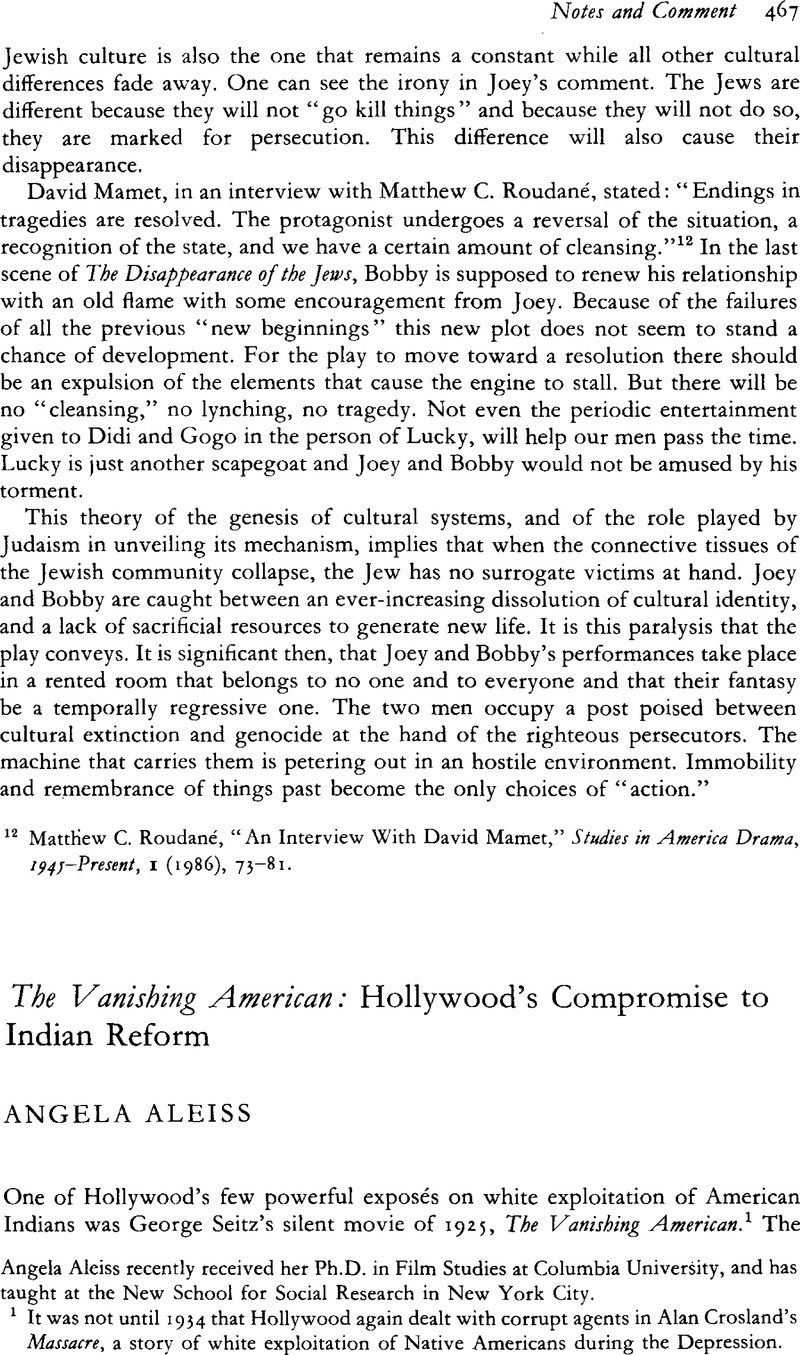No CrossRef data available.
Article contents
The Vanishing American: Hollywood's Compromise to Indian Reform
Published online by Cambridge University Press: 16 January 2009
Abstract

- Type
- Notes and Comment
- Information
- Copyright
- Copyright © Cambridge University Press 1991
References
1 It was not until 1934 that Hollywood again dealt with corrupt agents in Alan Crosland's Massacre, a story of white exploitation of Native Americans during the Depression.
2 See, for example, the following issues: Current History Magazine (07, 1923), 630–36Google Scholar; Review of Reviews (04 1926), 435–36Google Scholar; Outlook (18 11 1952), 441–44Google Scholar; Collier's (12 05 1923), 13Google Scholar; and Scientific American (01 1926), 5–7.Google Scholar
3 Collier, John, “America's Treatment of Her Indians,” Current History Magazine, New York Times, 18 08 1923, 771.Google Scholar
4 Work, Hubert, “Our American Indians,” Saturday Evening Post, 31 05 1924.Google Scholar
5 Mrs. Heinigke, Otto, “Address of the President,” The National Board of Young Women's Christian Associations, Proceedings from the meeting held 4 12 1925Google Scholar in New York, 28–29, Huntington Free Library, National Museum of the American Indian (Smithsonian Institution), Bronx, New York.
6 Clark, John W. (Executive Secretary), Forty-Sixth Annual Report of the National Indian Association, Published by the Executive Board, 12 1925, 5–6, Huntington Free Library.Google Scholar
7 Downes, Randolph C., “A Crusade for Indian Reform,” Mississippi Valley Historical Review, 32 (1945), 340–41.Google Scholar
8 Stein, Gary C., “The Indian Citizenship Act of 1924,” New Mexico Historical Review, 47 (1972), 269.Google Scholar
9 Jackson, Carlton, Zane Grey (New York: Twayne, 1973), 22–25, 78.Google Scholar
10 “Producing Indian Film Was a Stupendous Task,” New York Times, 20 09 1925Google Scholar and The Vanishing American Souvenir Program, New York Public Library, Library and Museum of the Performing Arts, New York City.
11 Jackson, Carlton, Zane Grey (New York: Twayne, 1973), 80–81Google Scholar. Jackson relies upon Grey's personal correspondence regarding church reactions to his missionary portrayals. No public outcry against his story was evident in major periodicals at the time of the serial's publication.
12 Jackson quotes Grey from his letter to Briggs, William H., 23 05 1924, 81.Google Scholar
13 Ibid.
14 Lathrop, M. C., “Story Synopsis and Comment,” 8 04 1923, 1–2Google Scholar, Paramount Collection, Margaret Herrick Library, Academy of Motion Picture Arts and Sciences, Beverly Hills, California.
15 Nopah is a fictitious name, referring to the Navajo tribe.
16 Grey, Zane, “The Vanishing American,” in Ladies Home Journal, 39 (04 1923), 235.Google Scholar
17 Wheeler, Joseph, “Zane Grey's Impact on American Life and Letters: A Study in the Popular Novel,” Diss. George Peabody College for Teachers, Tennessee, 181–83.Google Scholar
18 Hubbard, Lucien, “Synopsis,” 10 04 1925, 11–12Google Scholar, Paramount Collection, Academy of Motion Picture Arts and Sciences.
19 Although the concepts of Darwinism, eugenics, and Aryanism were popular during the 1920s, social scientists became increasingly willing to accept the power of cultural determinants over individual behavior. Franz Boas (1858–1942) and Ruth Benedict (1887–1948) were both twentieth-century anthropologists who attacked evolutionary doctrine as neglecting to account for cultural similarities. Boas wrote numerous essays in the early 1920s bearing on the matter of evolutionary theory; many were reprinted in his Race, Language and Culture (1940).Google Scholar
20 Lathrop, M. C., “Story Synopsis and Comment,” 8 04 1923, 1Google Scholar, Paramount Collection, Academy of Motion Picture Arts and Sciences.


